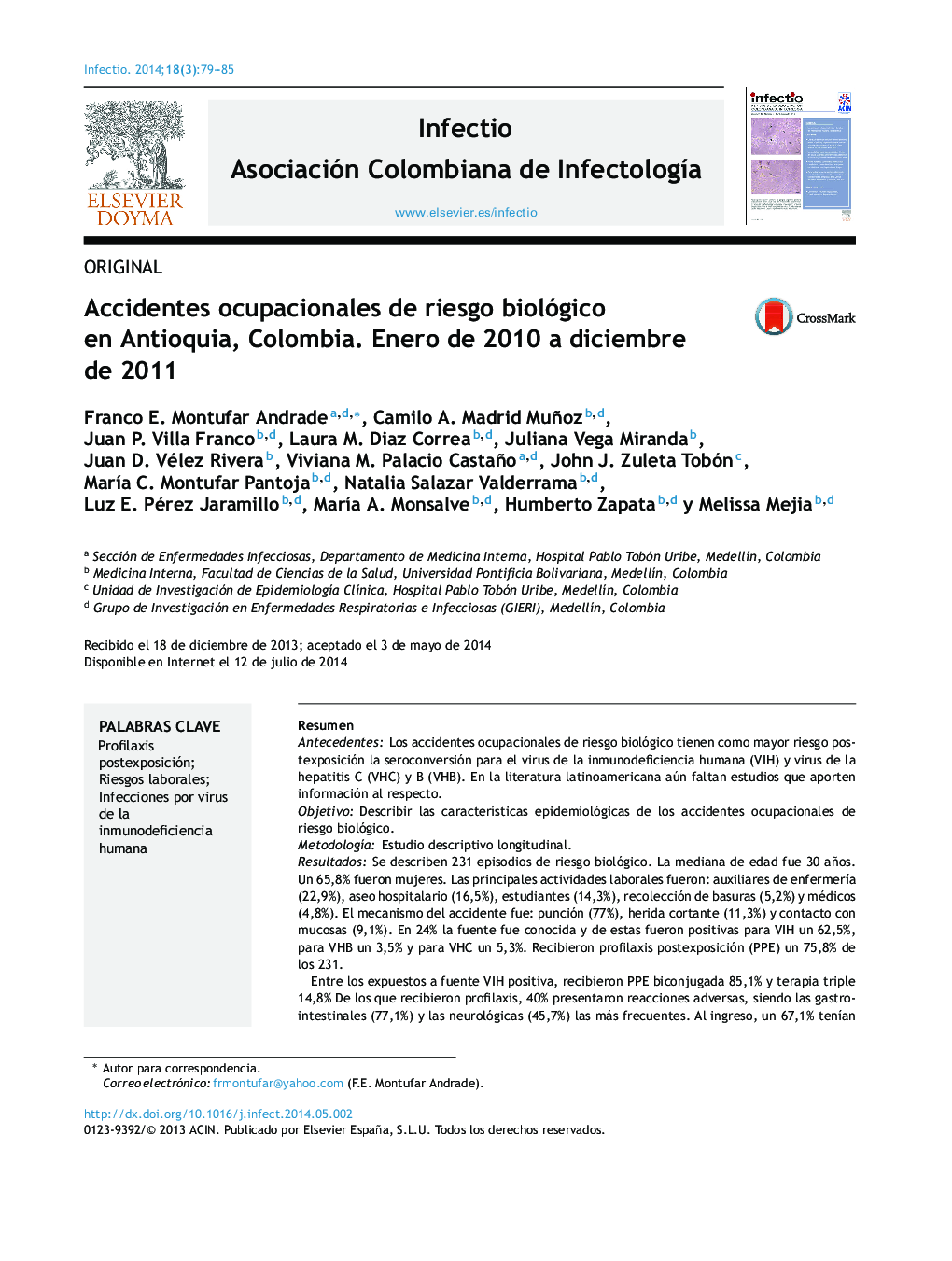| Article ID | Journal | Published Year | Pages | File Type |
|---|---|---|---|---|
| 3403756 | Infectio | 2014 | 7 Pages |
ResumenAntecedentesLos accidentes ocupacionales de riesgo biológico tienen como mayor riesgo postexposición la seroconversión para el virus de la inmunodeficiencia humana (VIH) y virus de la hepatitis C (VHC) y B (VHB). En la literatura latinoamericana aún faltan estudios que aporten información al respecto.ObjetivoDescribir las características epidemiológicas de los accidentes ocupacionales de riesgo biológico.MetodologíaEstudio descriptivo longitudinal.ResultadosSe describen 231 episodios de riesgo biológico. La mediana de edad fue 30 años. Un 65,8% fueron mujeres. Las principales actividades laborales fueron: auxiliares de enfermería (22,9%), aseo hospitalario (16,5%), estudiantes (14,3%), recolección de basuras (5,2%) y médicos (4,8%). El mecanismo del accidente fue: punción (77%), herida cortante (11,3%) y contacto con mucosas (9,1%). En 24% la fuente fue conocida y de estas fueron positivas para VIH un 62,5%, para VHB un 3,5% y para VHC un 5,3%. Recibieron profilaxis postexposición (PPE) un 75,8% de los 231.Entre los expuestos a fuente VIH positiva, recibieron PPE biconjugada 85,1% y terapia triple 14,8% De los que recibieron profilaxis, 40% presentaron reacciones adversas, siendo las gastrointestinales (77,1%) y las neurológicas (45,7%) las más frecuentes. Al ingreso, un 67,1% tenían anticuerpos protectores para VHB. Durante el seguimiento se confirmó una seroconversión postexposición para VIH.ConclusiónEl riesgo de adquirir infecciones postexposición ocupacional es una realidad en nuestro medio; se debe hacer énfasis en estrategias de prevención de exposición, introyectar la cultura del reporte y el manejo adecuado de la profilaxis postexposición.
BackgroundOccupational biohazard exposure can increase the risk of postexposure seroconversion of human immunodeficiency virus (HIV) and hepatitis C (HCV) and B virus (HBV). In Latin America, the literature lack of studies on this topic.ObjectiveTo describe the epidemiological characteristics of occupational biohazard exposure.MethodologyA descriptive, longitudinal study.ResultsA total of 231 episodes of biological risk exposure are described. The median age was 30 years, and 65.8% were women. The major occupational activities were: nursing assistants 22.9%, hospital cleaning 16.5%, students 14.3%, garbage collection 5.2% and physicians 4.8%. The mechanisms of the accidents were: needle stick 77%, cutting wound 11.3% and contact with mucous membranes 9.1%. In 24% the source was known and of these, 62.5% were positive for HIV 3.5% for HBV and 5.3% for HCV. A total of 75.8% of the 231 received postexposure prophylaxis (PEP).In those exposed to an HIV-positive source, 85.1% received a two-drug conjugate for PPE, and 14.8% received triple therapy. Of those who received prophylaxis, 40% reported adverse events with being the most frequent the gastrointestinal (77.1%) and neurological (45.7%). At admission, 67.1% had protective antibodies to HBV. During program monitoring, HIV seroconversion was confirmed in one patient.ConclusionThe risk of acquiring occupational infections postexposure is a reality in our country. This emphasizes the importance of exposure prevention strategies, introjecting the reporting culture and proper management of postexposure prophylaxis.
